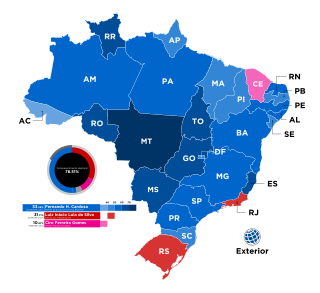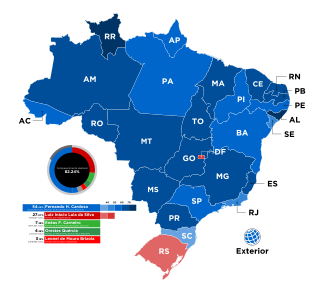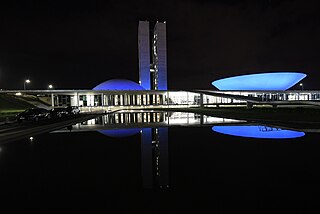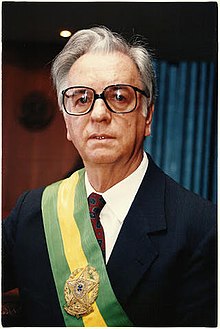
Fernando Affonso Collor de Mello is a Brazilian politician who served as the 32nd president of Brazil from 1990 to 1992, when he resigned in a failed attempt to stop his impeachment trial by the Brazilian Senate. Collor was the first president democratically elected after the end of the Brazilian military dictatorship. He became the youngest president in Brazilian history, taking office at the age of 40. After he resigned from the presidency, the impeachment trial on charges of corruption continued. Collor was found guilty by the Senate and disqualified from holding elected office for eight years (1992–2000). He was later acquitted of ordinary criminal charges in his judicial trial before Brazil's Supreme Federal Court, for lack of valid evidence.

Itamar Augusto Cautiero Franco was a Brazilian politician who served as the 33rd president of Brazil from 29 December 1992 to 1 January 1995. Previously, he was the 21st vice president of Brazil from 1990 until the resignation of President Fernando Collor de Mello. During his long political career Franco also served as Senator, Mayor, Ambassador and Governor. At the time of his death he was a senator from Minas Gerais, having won the seat in the 2010 election.

Brazilian history from 1985 to the present, also known as the Sixth Brazilian Republic or New Republic, is the contemporary epoch in the history of Brazil, beginning when civilian government was restored after a 21-year-long military dictatorship established after the 1964 coup d'état. The negotiated transition to democracy reached its climax with the indirect election of Tancredo Neves by Congress. Neves belonged to the Brazilian Democratic Movement Party (MDB), the former controlled opposition to the military regime. He was the first civilian president to be elected since 1964.
The following is a timeline of the Brazilian economic stabilization plans in the "new Republic" era, a period characterized by intense inflation of the local currency, exceeding 2,700% in the period of 1989 to 1990.

The Collor Plan, is the name given to a collection of economic reforms and inflation-stabilization plans carried out in Brazil during the presidency of Fernando Collor de Mello, between 1990 and 1992. The plan was officially called New Brazil Plan, but it became closely associated with Collor himself, and "Plano Collor" became its de facto name.
Agir is a political party in Brazil, established in 1985. It was founded as the Youth Party, and was renamed the National Reconstruction Party in 1989, and the Christian Labor Party in 2000. The party was renamed Agir in 2021, a change ratified by the Superior Electoral Court the following year.

The Ministry of Education, commonly known as MEC, originates from its previous name, the Ministry of Education and Culture, is a cabinet-level federal ministry of Brazil.

General elections were held in Brazil on 4 October 1998 to elect the President, National Congress and state governorships. If no candidate in the presidential election received more than 50% of the vote in the first round, a second-round runoff would have been held on 25 October. The election saw voting machines used for the first time in Brazilian history.

Fernando Haddad is a Brazilian scholar, lawyer and politician who has served as the Brazilian Minister of Finance since 1 January 2023. He was previously the mayor of São Paulo from 2013 to 2017 and the Brazilian minister of education from 2005 to 2012.

General elections were held in Brazil on October 3, 1994, the second to take place under the provisions of the 1988 constitution and the second direct presidential election since 1960.

Maílson Ferreira da Nóbrega is a Brazilian economist. He was Finance minister in José Sarney's administration during a period of hyperinflation in the late 1980s. He is married and has five children.

Events in the year 1993 in Brazil.

Events in the year 1994 in Brazil.
Albertina de Oliveira Costa is a Brazilian sociologist, editor, theoretician and feminist activist. A member of the Carlos Chagas Foundation, she is one of the principal investigators of issues related to women's studies in Brazil. Costa graduated with a degree in social sciences from the University of São Paulo. Her theoretical themes are in the field of gender studies but from a feminist perspective closer to activism, defending the rights of women, public policies and human rights. She is a member of the National Council for the Rights of Women and is editor of the journal Cadernos de Pesquisa. She has also collaborated in Revista Estudos Feministas and in Cadernos Pagu while sitting on the executive committee of the International Journal of Human Rights.

The Collor government, also referred to as the Collor Era, was a period in Brazilian political history that began with the inauguration of President Fernando Collor de Mello on 15 March 1990, and ended with his resignation from the presidency on 29 December 1992. Fernando Collor was the first president elected by the people since 1960, when Jânio Quadros won the last direct election for president before the beginning of the Military Dictatorship. His removal from office on 2 October 1992, was a consequence of his impeachment proceedings the day before, followed by cassation.
After the 1994 election, Fernando Henrique Cardoso became 35th President of Brazil and the second president elected by direct popular vote after the redemocratization. His government was marked by economic stabilization after the consolidation of Plano Real, which he was part of. A second cabinet was formed after the 1998 election, the first when an incumbent president could run for a second consecutive term.

The presidency of Fernando Henrique Cardoso began on 1 January 1995, with the inauguration of Fernando Henrique, also known as FHC, and ended on 1 January 2003, when Luiz Inácio Lula da Silva took over the presidency.

The impeachment of Fernando Collor, the 32th president of Brazil, began on 29 September 1992, when the Chamber of Deputies approved the opening of impeachment procedures with 441 votes in favour. On 29 December 1992, when the trial began in the Federal Senate, Collor resigned in a letter read out by lawyer José Moura Rocha to avoid impeachment. However, the following day, Collor was sentenced to be disqualified from holding public office for eight years by 76 votes in favour and 2 against. It was Brazil's third impeachment trial; in 1955, Presidents Carlos Luz and Café Filho were also impeached.

Autism in Brazil has had a number of manifestations since the 20th century. It was introduced through child psychiatry with the predominant influence of psychoanalysis in medical care in the mid-1950s. The development of a community based on autism was late, with the founding of the Associação de Amigos do Autista (AMA) in 1983. Since then, autism has become a topic of interest for family members, health professionals and autistic people with the predominance of a neurobiological view of the diagnosis.
Third Way politics have been used to describe many types of Brazilian political groups, vaugely ranging the political center. Stemming from the Brazilian Social Democracy Party, the Third Way movement in Brazil saw its hight during the presidency of Fernando Henrique Cardoso. In modern Brazilian politics, the term is more commonly used for politics in opposition or unaligned with the dominant forces of the left-wing Workers' Party and those of Jair Bolsonaro..














